Comprehensive Report: Literature Review and CSR in Business
VerifiedAdded on 2021/01/02
|10
|2512
|171
Report
AI Summary
This report provides a comprehensive overview of literature review and corporate social responsibility (CSR). It begins by defining literature review, explaining its importance, and outlining its structure. The report then delves into the meaning and need for CSR in organizations, highlighting its benefits for stakeholders and society. It explores the CSR pyramid, detailing the economic, legal, ethical, and philanthropic responsibilities of corporations. Furthermore, the report addresses various issues companies face when implementing CSR models, such as human rights, environmental changes, and customer preferences. The conclusion summarizes the key aspects of the literature review, the importance of LR, the definition of CSR, and the issues associated with its implementation, reinforcing the significance of CSR in contemporary business practices. This report is a valuable resource for understanding CSR and its practical implications.

STUDY SKILLS( REPORT)
Paraphrase This Document
Need a fresh take? Get an instant paraphrase of this document with our AI Paraphraser
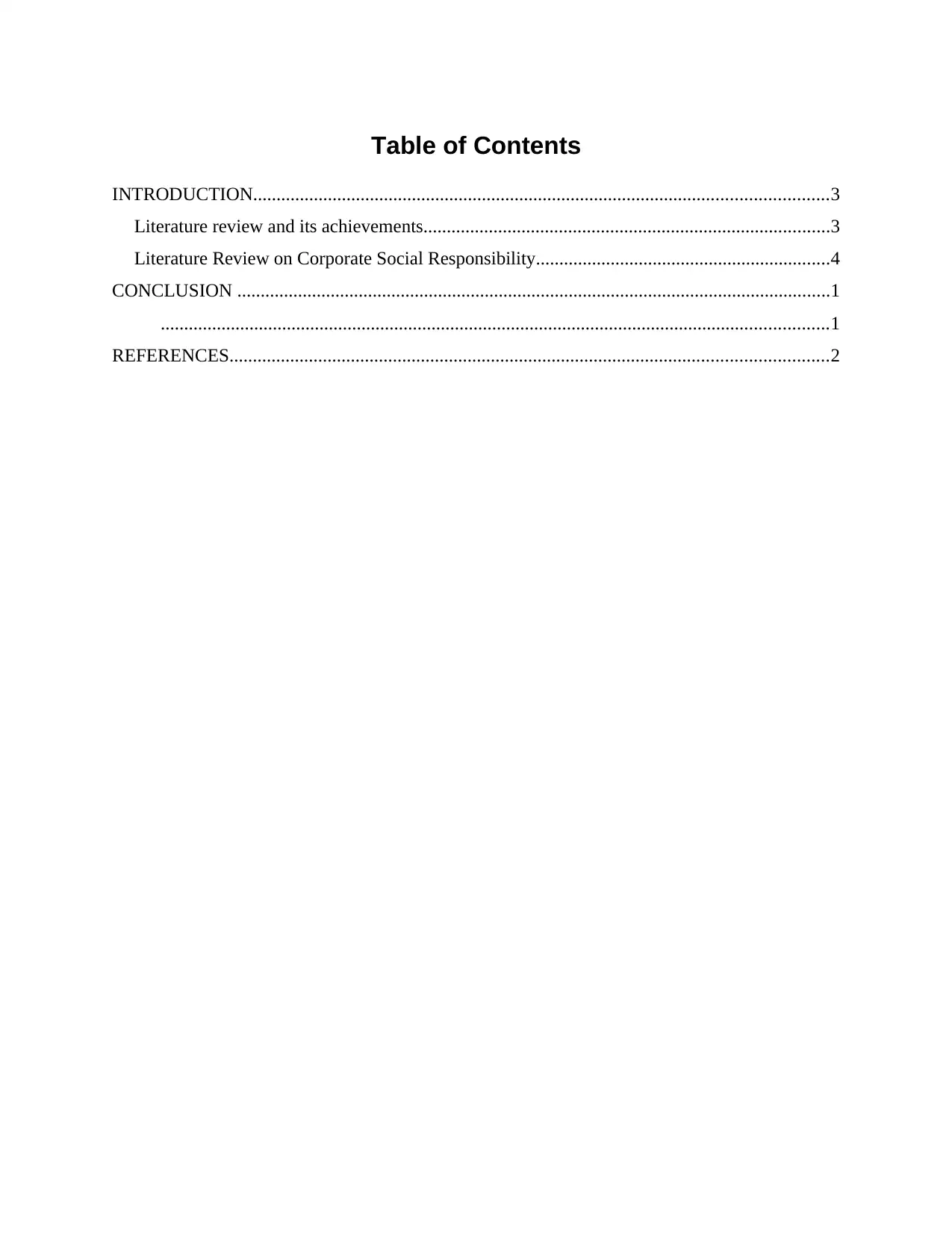
Table of Contents
INTRODUCTION...........................................................................................................................3
Literature review and its achievements.......................................................................................3
Literature Review on Corporate Social Responsibility...............................................................4
CONCLUSION ...............................................................................................................................1
...............................................................................................................................................1
REFERENCES................................................................................................................................2
INTRODUCTION...........................................................................................................................3
Literature review and its achievements.......................................................................................3
Literature Review on Corporate Social Responsibility...............................................................4
CONCLUSION ...............................................................................................................................1
...............................................................................................................................................1
REFERENCES................................................................................................................................2
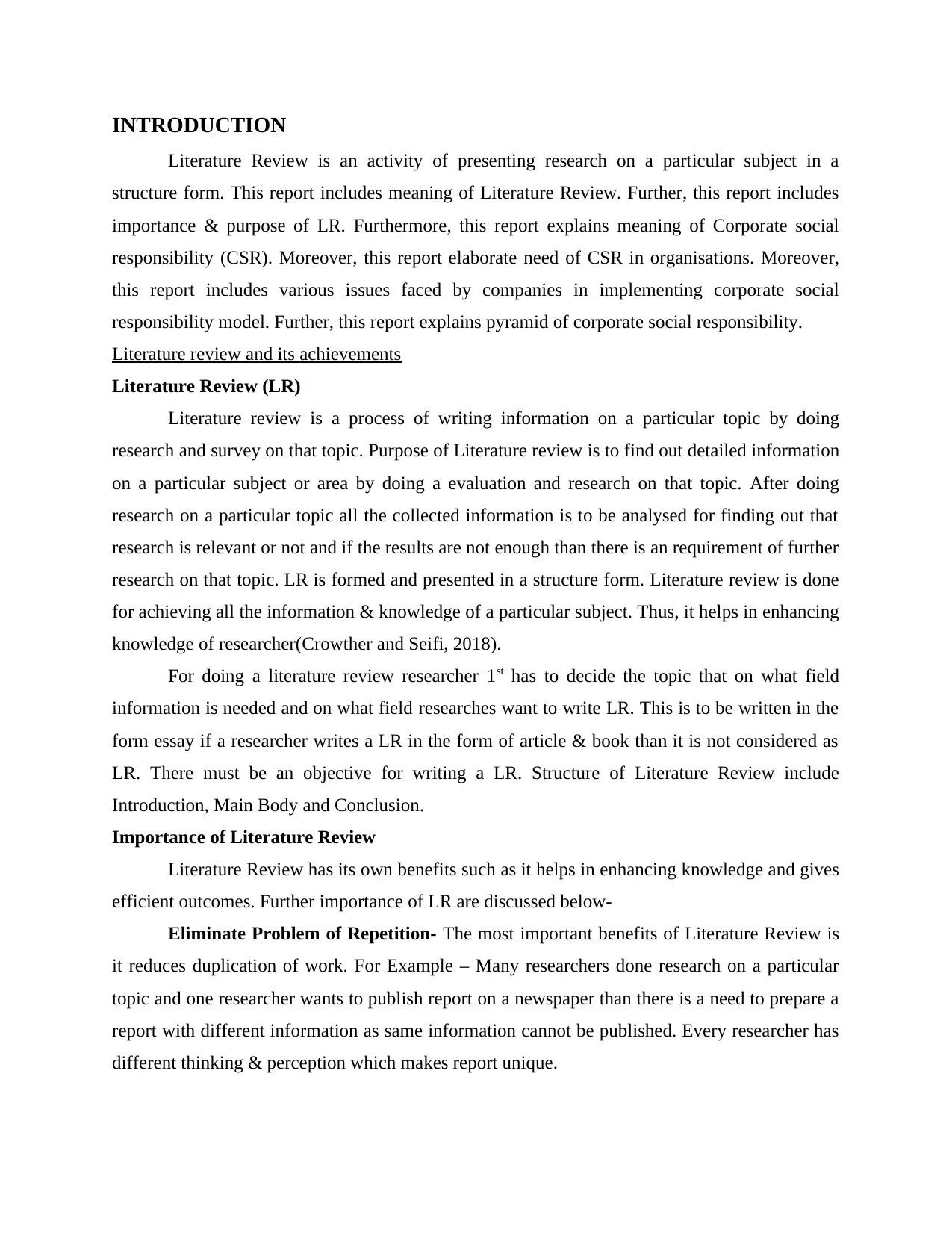
INTRODUCTION
Literature Review is an activity of presenting research on a particular subject in a
structure form. This report includes meaning of Literature Review. Further, this report includes
importance & purpose of LR. Furthermore, this report explains meaning of Corporate social
responsibility (CSR). Moreover, this report elaborate need of CSR in organisations. Moreover,
this report includes various issues faced by companies in implementing corporate social
responsibility model. Further, this report explains pyramid of corporate social responsibility.
Literature review and its achievements
Literature Review (LR)
Literature review is a process of writing information on a particular topic by doing
research and survey on that topic. Purpose of Literature review is to find out detailed information
on a particular subject or area by doing a evaluation and research on that topic. After doing
research on a particular topic all the collected information is to be analysed for finding out that
research is relevant or not and if the results are not enough than there is an requirement of further
research on that topic. LR is formed and presented in a structure form. Literature review is done
for achieving all the information & knowledge of a particular subject. Thus, it helps in enhancing
knowledge of researcher(Crowther and Seifi, 2018).
For doing a literature review researcher 1st has to decide the topic that on what field
information is needed and on what field researches want to write LR. This is to be written in the
form essay if a researcher writes a LR in the form of article & book than it is not considered as
LR. There must be an objective for writing a LR. Structure of Literature Review include
Introduction, Main Body and Conclusion.
Importance of Literature Review
Literature Review has its own benefits such as it helps in enhancing knowledge and gives
efficient outcomes. Further importance of LR are discussed below-
Eliminate Problem of Repetition- The most important benefits of Literature Review is
it reduces duplication of work. For Example – Many researchers done research on a particular
topic and one researcher wants to publish report on a newspaper than there is a need to prepare a
report with different information as same information cannot be published. Every researcher has
different thinking & perception which makes report unique.
Literature Review is an activity of presenting research on a particular subject in a
structure form. This report includes meaning of Literature Review. Further, this report includes
importance & purpose of LR. Furthermore, this report explains meaning of Corporate social
responsibility (CSR). Moreover, this report elaborate need of CSR in organisations. Moreover,
this report includes various issues faced by companies in implementing corporate social
responsibility model. Further, this report explains pyramid of corporate social responsibility.
Literature review and its achievements
Literature Review (LR)
Literature review is a process of writing information on a particular topic by doing
research and survey on that topic. Purpose of Literature review is to find out detailed information
on a particular subject or area by doing a evaluation and research on that topic. After doing
research on a particular topic all the collected information is to be analysed for finding out that
research is relevant or not and if the results are not enough than there is an requirement of further
research on that topic. LR is formed and presented in a structure form. Literature review is done
for achieving all the information & knowledge of a particular subject. Thus, it helps in enhancing
knowledge of researcher(Crowther and Seifi, 2018).
For doing a literature review researcher 1st has to decide the topic that on what field
information is needed and on what field researches want to write LR. This is to be written in the
form essay if a researcher writes a LR in the form of article & book than it is not considered as
LR. There must be an objective for writing a LR. Structure of Literature Review include
Introduction, Main Body and Conclusion.
Importance of Literature Review
Literature Review has its own benefits such as it helps in enhancing knowledge and gives
efficient outcomes. Further importance of LR are discussed below-
Eliminate Problem of Repetition- The most important benefits of Literature Review is
it reduces duplication of work. For Example – Many researchers done research on a particular
topic and one researcher wants to publish report on a newspaper than there is a need to prepare a
report with different information as same information cannot be published. Every researcher has
different thinking & perception which makes report unique.
⊘ This is a preview!⊘
Do you want full access?
Subscribe today to unlock all pages.

Trusted by 1+ million students worldwide
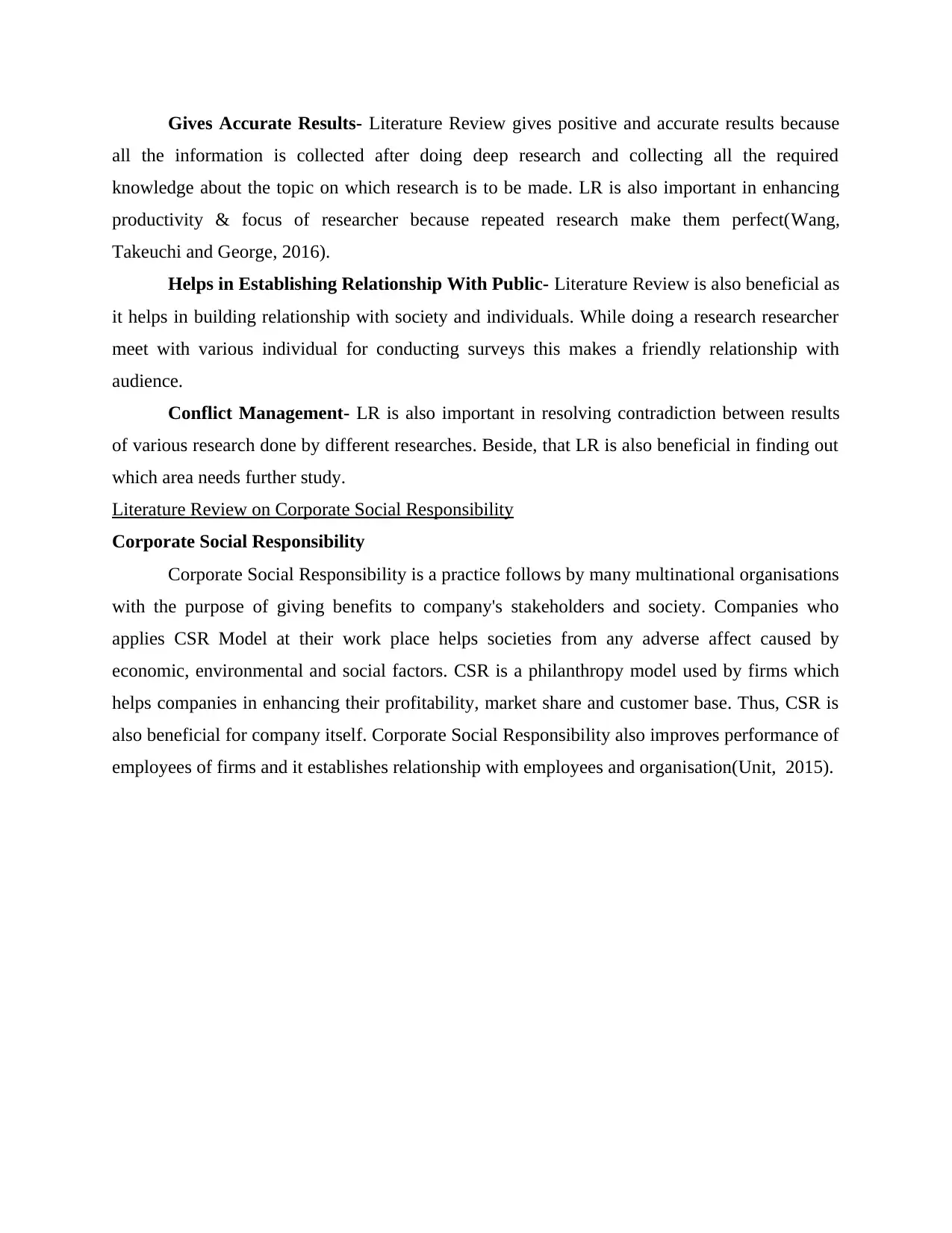
Gives Accurate Results- Literature Review gives positive and accurate results because
all the information is collected after doing deep research and collecting all the required
knowledge about the topic on which research is to be made. LR is also important in enhancing
productivity & focus of researcher because repeated research make them perfect(Wang,
Takeuchi and George, 2016).
Helps in Establishing Relationship With Public- Literature Review is also beneficial as
it helps in building relationship with society and individuals. While doing a research researcher
meet with various individual for conducting surveys this makes a friendly relationship with
audience.
Conflict Management- LR is also important in resolving contradiction between results
of various research done by different researches. Beside, that LR is also beneficial in finding out
which area needs further study.
Literature Review on Corporate Social Responsibility
Corporate Social Responsibility
Corporate Social Responsibility is a practice follows by many multinational organisations
with the purpose of giving benefits to company's stakeholders and society. Companies who
applies CSR Model at their work place helps societies from any adverse affect caused by
economic, environmental and social factors. CSR is a philanthropy model used by firms which
helps companies in enhancing their profitability, market share and customer base. Thus, CSR is
also beneficial for company itself. Corporate Social Responsibility also improves performance of
employees of firms and it establishes relationship with employees and organisation(Unit, 2015).
all the information is collected after doing deep research and collecting all the required
knowledge about the topic on which research is to be made. LR is also important in enhancing
productivity & focus of researcher because repeated research make them perfect(Wang,
Takeuchi and George, 2016).
Helps in Establishing Relationship With Public- Literature Review is also beneficial as
it helps in building relationship with society and individuals. While doing a research researcher
meet with various individual for conducting surveys this makes a friendly relationship with
audience.
Conflict Management- LR is also important in resolving contradiction between results
of various research done by different researches. Beside, that LR is also beneficial in finding out
which area needs further study.
Literature Review on Corporate Social Responsibility
Corporate Social Responsibility
Corporate Social Responsibility is a practice follows by many multinational organisations
with the purpose of giving benefits to company's stakeholders and society. Companies who
applies CSR Model at their work place helps societies from any adverse affect caused by
economic, environmental and social factors. CSR is a philanthropy model used by firms which
helps companies in enhancing their profitability, market share and customer base. Thus, CSR is
also beneficial for company itself. Corporate Social Responsibility also improves performance of
employees of firms and it establishes relationship with employees and organisation(Unit, 2015).
Paraphrase This Document
Need a fresh take? Get an instant paraphrase of this document with our AI Paraphraser
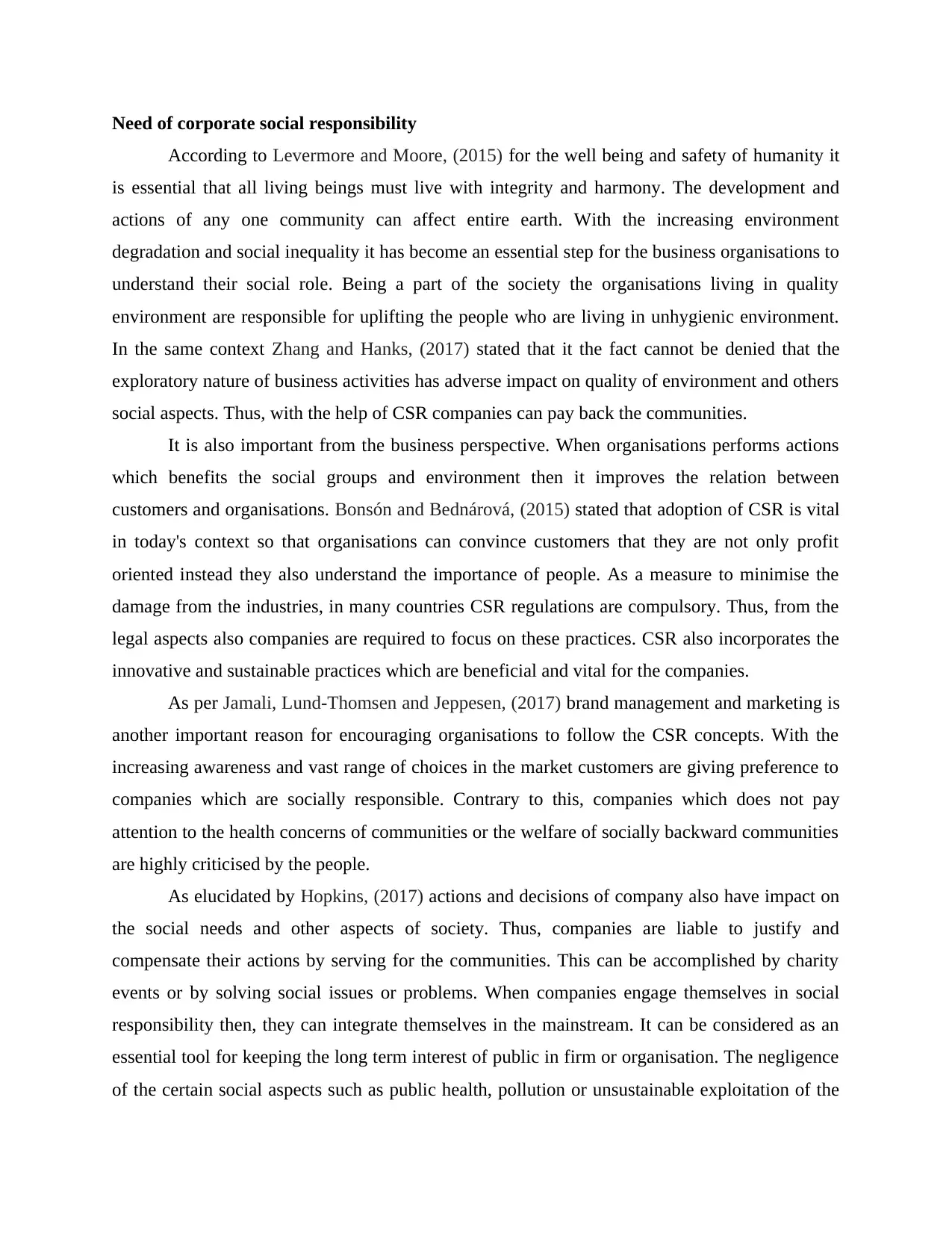
Need of corporate social responsibility
According to Levermore and Moore, (2015) for the well being and safety of humanity it
is essential that all living beings must live with integrity and harmony. The development and
actions of any one community can affect entire earth. With the increasing environment
degradation and social inequality it has become an essential step for the business organisations to
understand their social role. Being a part of the society the organisations living in quality
environment are responsible for uplifting the people who are living in unhygienic environment.
In the same context Zhang and Hanks, (2017) stated that it the fact cannot be denied that the
exploratory nature of business activities has adverse impact on quality of environment and others
social aspects. Thus, with the help of CSR companies can pay back the communities.
It is also important from the business perspective. When organisations performs actions
which benefits the social groups and environment then it improves the relation between
customers and organisations. Bonsón and Bednárová, (2015) stated that adoption of CSR is vital
in today's context so that organisations can convince customers that they are not only profit
oriented instead they also understand the importance of people. As a measure to minimise the
damage from the industries, in many countries CSR regulations are compulsory. Thus, from the
legal aspects also companies are required to focus on these practices. CSR also incorporates the
innovative and sustainable practices which are beneficial and vital for the companies.
As per Jamali, Lund-Thomsen and Jeppesen, (2017) brand management and marketing is
another important reason for encouraging organisations to follow the CSR concepts. With the
increasing awareness and vast range of choices in the market customers are giving preference to
companies which are socially responsible. Contrary to this, companies which does not pay
attention to the health concerns of communities or the welfare of socially backward communities
are highly criticised by the people.
As elucidated by Hopkins, (2017) actions and decisions of company also have impact on
the social needs and other aspects of society. Thus, companies are liable to justify and
compensate their actions by serving for the communities. This can be accomplished by charity
events or by solving social issues or problems. When companies engage themselves in social
responsibility then, they can integrate themselves in the mainstream. It can be considered as an
essential tool for keeping the long term interest of public in firm or organisation. The negligence
of the certain social aspects such as public health, pollution or unsustainable exploitation of the
According to Levermore and Moore, (2015) for the well being and safety of humanity it
is essential that all living beings must live with integrity and harmony. The development and
actions of any one community can affect entire earth. With the increasing environment
degradation and social inequality it has become an essential step for the business organisations to
understand their social role. Being a part of the society the organisations living in quality
environment are responsible for uplifting the people who are living in unhygienic environment.
In the same context Zhang and Hanks, (2017) stated that it the fact cannot be denied that the
exploratory nature of business activities has adverse impact on quality of environment and others
social aspects. Thus, with the help of CSR companies can pay back the communities.
It is also important from the business perspective. When organisations performs actions
which benefits the social groups and environment then it improves the relation between
customers and organisations. Bonsón and Bednárová, (2015) stated that adoption of CSR is vital
in today's context so that organisations can convince customers that they are not only profit
oriented instead they also understand the importance of people. As a measure to minimise the
damage from the industries, in many countries CSR regulations are compulsory. Thus, from the
legal aspects also companies are required to focus on these practices. CSR also incorporates the
innovative and sustainable practices which are beneficial and vital for the companies.
As per Jamali, Lund-Thomsen and Jeppesen, (2017) brand management and marketing is
another important reason for encouraging organisations to follow the CSR concepts. With the
increasing awareness and vast range of choices in the market customers are giving preference to
companies which are socially responsible. Contrary to this, companies which does not pay
attention to the health concerns of communities or the welfare of socially backward communities
are highly criticised by the people.
As elucidated by Hopkins, (2017) actions and decisions of company also have impact on
the social needs and other aspects of society. Thus, companies are liable to justify and
compensate their actions by serving for the communities. This can be accomplished by charity
events or by solving social issues or problems. When companies engage themselves in social
responsibility then, they can integrate themselves in the mainstream. It can be considered as an
essential tool for keeping the long term interest of public in firm or organisation. The negligence
of the certain social aspects such as public health, pollution or unsustainable exploitation of the
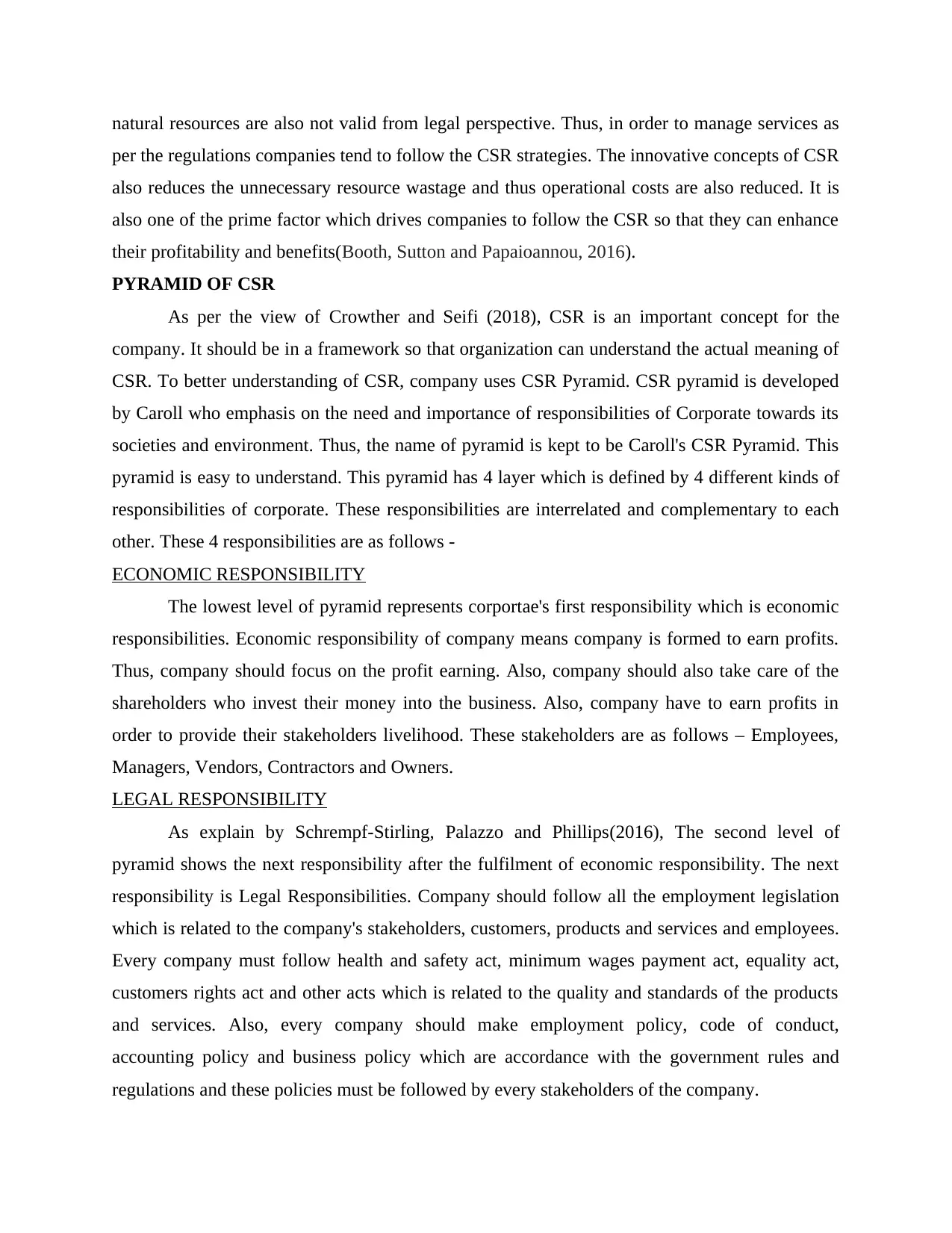
natural resources are also not valid from legal perspective. Thus, in order to manage services as
per the regulations companies tend to follow the CSR strategies. The innovative concepts of CSR
also reduces the unnecessary resource wastage and thus operational costs are also reduced. It is
also one of the prime factor which drives companies to follow the CSR so that they can enhance
their profitability and benefits(Booth, Sutton and Papaioannou, 2016).
PYRAMID OF CSR
As per the view of Crowther and Seifi (2018), CSR is an important concept for the
company. It should be in a framework so that organization can understand the actual meaning of
CSR. To better understanding of CSR, company uses CSR Pyramid. CSR pyramid is developed
by Caroll who emphasis on the need and importance of responsibilities of Corporate towards its
societies and environment. Thus, the name of pyramid is kept to be Caroll's CSR Pyramid. This
pyramid is easy to understand. This pyramid has 4 layer which is defined by 4 different kinds of
responsibilities of corporate. These responsibilities are interrelated and complementary to each
other. These 4 responsibilities are as follows -
ECONOMIC RESPONSIBILITY
The lowest level of pyramid represents corportae's first responsibility which is economic
responsibilities. Economic responsibility of company means company is formed to earn profits.
Thus, company should focus on the profit earning. Also, company should also take care of the
shareholders who invest their money into the business. Also, company have to earn profits in
order to provide their stakeholders livelihood. These stakeholders are as follows – Employees,
Managers, Vendors, Contractors and Owners.
LEGAL RESPONSIBILITY
As explain by Schrempf-Stirling, Palazzo and Phillips(2016), The second level of
pyramid shows the next responsibility after the fulfilment of economic responsibility. The next
responsibility is Legal Responsibilities. Company should follow all the employment legislation
which is related to the company's stakeholders, customers, products and services and employees.
Every company must follow health and safety act, minimum wages payment act, equality act,
customers rights act and other acts which is related to the quality and standards of the products
and services. Also, every company should make employment policy, code of conduct,
accounting policy and business policy which are accordance with the government rules and
regulations and these policies must be followed by every stakeholders of the company.
per the regulations companies tend to follow the CSR strategies. The innovative concepts of CSR
also reduces the unnecessary resource wastage and thus operational costs are also reduced. It is
also one of the prime factor which drives companies to follow the CSR so that they can enhance
their profitability and benefits(Booth, Sutton and Papaioannou, 2016).
PYRAMID OF CSR
As per the view of Crowther and Seifi (2018), CSR is an important concept for the
company. It should be in a framework so that organization can understand the actual meaning of
CSR. To better understanding of CSR, company uses CSR Pyramid. CSR pyramid is developed
by Caroll who emphasis on the need and importance of responsibilities of Corporate towards its
societies and environment. Thus, the name of pyramid is kept to be Caroll's CSR Pyramid. This
pyramid is easy to understand. This pyramid has 4 layer which is defined by 4 different kinds of
responsibilities of corporate. These responsibilities are interrelated and complementary to each
other. These 4 responsibilities are as follows -
ECONOMIC RESPONSIBILITY
The lowest level of pyramid represents corportae's first responsibility which is economic
responsibilities. Economic responsibility of company means company is formed to earn profits.
Thus, company should focus on the profit earning. Also, company should also take care of the
shareholders who invest their money into the business. Also, company have to earn profits in
order to provide their stakeholders livelihood. These stakeholders are as follows – Employees,
Managers, Vendors, Contractors and Owners.
LEGAL RESPONSIBILITY
As explain by Schrempf-Stirling, Palazzo and Phillips(2016), The second level of
pyramid shows the next responsibility after the fulfilment of economic responsibility. The next
responsibility is Legal Responsibilities. Company should follow all the employment legislation
which is related to the company's stakeholders, customers, products and services and employees.
Every company must follow health and safety act, minimum wages payment act, equality act,
customers rights act and other acts which is related to the quality and standards of the products
and services. Also, every company should make employment policy, code of conduct,
accounting policy and business policy which are accordance with the government rules and
regulations and these policies must be followed by every stakeholders of the company.
⊘ This is a preview!⊘
Do you want full access?
Subscribe today to unlock all pages.

Trusted by 1+ million students worldwide

ETHICAL RESPONSIBILITY
The Third level of pyramid refers to the next responsibility which is known as Ethical
Responsibility. Company should know what is right and what is wrong for their environment and
societies. Also, company should fairly operate its business in every aspects. Also, company
should also ignore its government laws when it comes to ethical aspect of business. Company
should also make code of ethics which must be apply to all its stakeholders including its
investors and customers as well. This can be fulfil by disclosure of financial statement to the
public.
PHILANTHROPIC RESPONSIBILITY
The first and foremost level of pyramid is occupied by its philanthropic responsibility in
which company should give back to the community all those resources which is taken by
businesses in order to run the business. Otherwise, communities won't support the business
which is very harmful for the business. These responsibilities can be fulfil by company if they do
donations, conduct various events for the environmental issues, charities, plantations and support
their communities in various social issues etc.
Issues Related to Corporate Social Responsibility
Corporate social responsibility is beneficial for companies and it help firms in expansion
of their operations but beside that companies also faces various issues in applying this model in
business. These issues are discussed below-
Issues related to Human Rights- While implementing CSR model in business a
company faces issue related to protection of human rights. Human rights followed by
organisations in applying in CSR practices does not lead to any fraudulent practices and all that
rights can be applicable at international level.
Environment Changes- Changes in environment is an issue in implementing CSR
practices because organisations have to form policies by keeping in mind various factors which
affects environment such as earthquake, rainfall and carbon footprint.
Issues related to Better Work-life- If a company is following CSR model than it is
responsible for establishing a positive work environment which eliminates child labour and
which does not force its employees to work. Organisation which is implementing corporate
social responsibility model in its business also faces an issue in providing trade union rights &
practices(Hart, 2018).
The Third level of pyramid refers to the next responsibility which is known as Ethical
Responsibility. Company should know what is right and what is wrong for their environment and
societies. Also, company should fairly operate its business in every aspects. Also, company
should also ignore its government laws when it comes to ethical aspect of business. Company
should also make code of ethics which must be apply to all its stakeholders including its
investors and customers as well. This can be fulfil by disclosure of financial statement to the
public.
PHILANTHROPIC RESPONSIBILITY
The first and foremost level of pyramid is occupied by its philanthropic responsibility in
which company should give back to the community all those resources which is taken by
businesses in order to run the business. Otherwise, communities won't support the business
which is very harmful for the business. These responsibilities can be fulfil by company if they do
donations, conduct various events for the environmental issues, charities, plantations and support
their communities in various social issues etc.
Issues Related to Corporate Social Responsibility
Corporate social responsibility is beneficial for companies and it help firms in expansion
of their operations but beside that companies also faces various issues in applying this model in
business. These issues are discussed below-
Issues related to Human Rights- While implementing CSR model in business a
company faces issue related to protection of human rights. Human rights followed by
organisations in applying in CSR practices does not lead to any fraudulent practices and all that
rights can be applicable at international level.
Environment Changes- Changes in environment is an issue in implementing CSR
practices because organisations have to form policies by keeping in mind various factors which
affects environment such as earthquake, rainfall and carbon footprint.
Issues related to Better Work-life- If a company is following CSR model than it is
responsible for establishing a positive work environment which eliminates child labour and
which does not force its employees to work. Organisation which is implementing corporate
social responsibility model in its business also faces an issue in providing trade union rights &
practices(Hart, 2018).
Paraphrase This Document
Need a fresh take? Get an instant paraphrase of this document with our AI Paraphraser

Issues related to Discloser- Any organisation who is applying corporate social
responsibility model in its organisation has to give detailed information about its operation to
public & society and company also require to give full discloser about its profits and products &
services. In this company faces an issue of disclosing its personal information and there is also
an issue of disclosing this information on time to time.
Changes in Customers Preferences- The biggest issues faces by organisation in
implementing CSR practices in their operations is they have to consider interest of customers.
Companies has to change their operations and offerings of products & services according to
demand & preference of customers. Interest of customers changes time to time so its difficult for
company to change its offering accordingly(Wang, Takeuchi and George, 2016).
responsibility model in its organisation has to give detailed information about its operation to
public & society and company also require to give full discloser about its profits and products &
services. In this company faces an issue of disclosing its personal information and there is also
an issue of disclosing this information on time to time.
Changes in Customers Preferences- The biggest issues faces by organisation in
implementing CSR practices in their operations is they have to consider interest of customers.
Companies has to change their operations and offerings of products & services according to
demand & preference of customers. Interest of customers changes time to time so its difficult for
company to change its offering accordingly(Wang, Takeuchi and George, 2016).
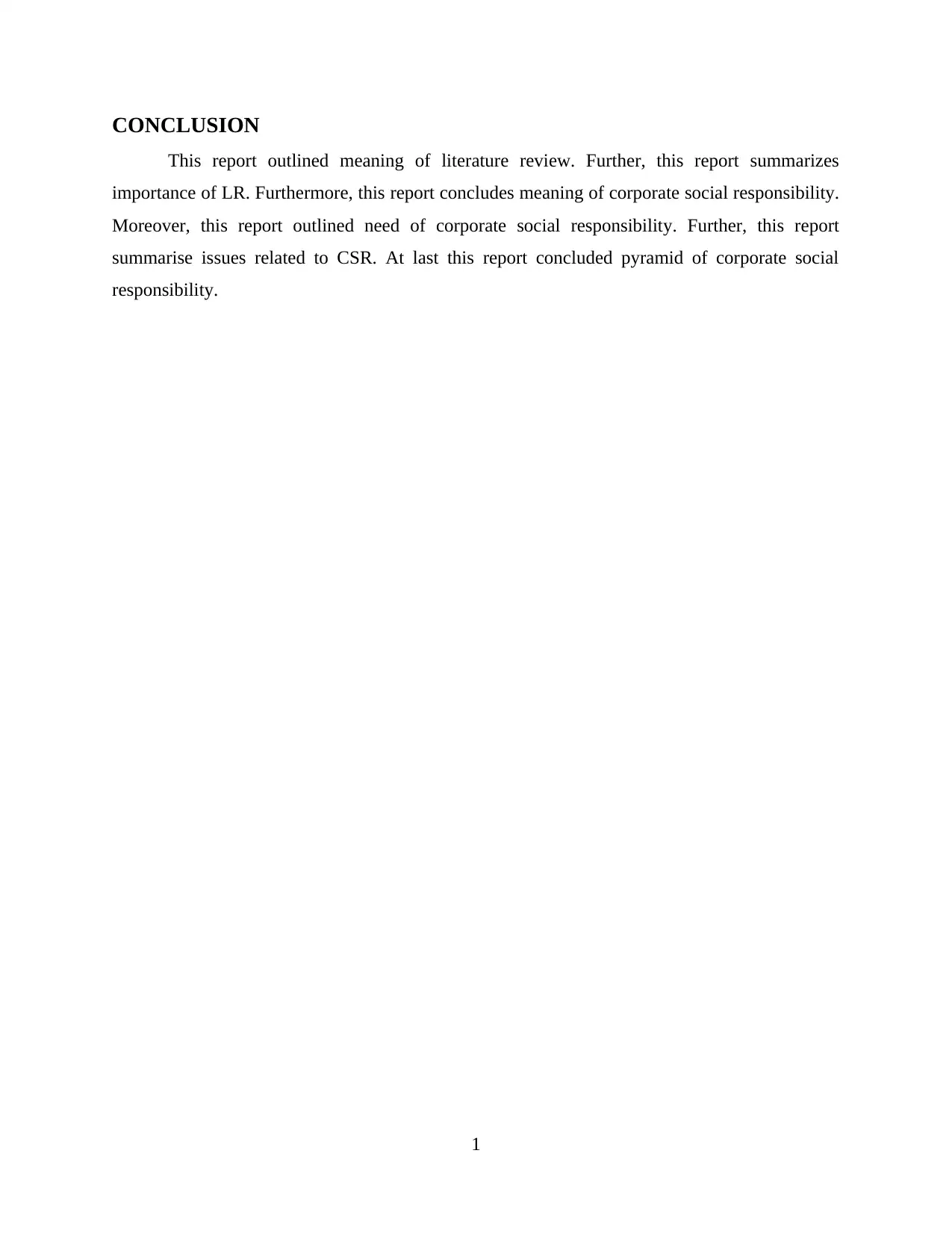
CONCLUSION
This report outlined meaning of literature review. Further, this report summarizes
importance of LR. Furthermore, this report concludes meaning of corporate social responsibility.
Moreover, this report outlined need of corporate social responsibility. Further, this report
summarise issues related to CSR. At last this report concluded pyramid of corporate social
responsibility.
1
This report outlined meaning of literature review. Further, this report summarizes
importance of LR. Furthermore, this report concludes meaning of corporate social responsibility.
Moreover, this report outlined need of corporate social responsibility. Further, this report
summarise issues related to CSR. At last this report concluded pyramid of corporate social
responsibility.
1
⊘ This is a preview!⊘
Do you want full access?
Subscribe today to unlock all pages.

Trusted by 1+ million students worldwide
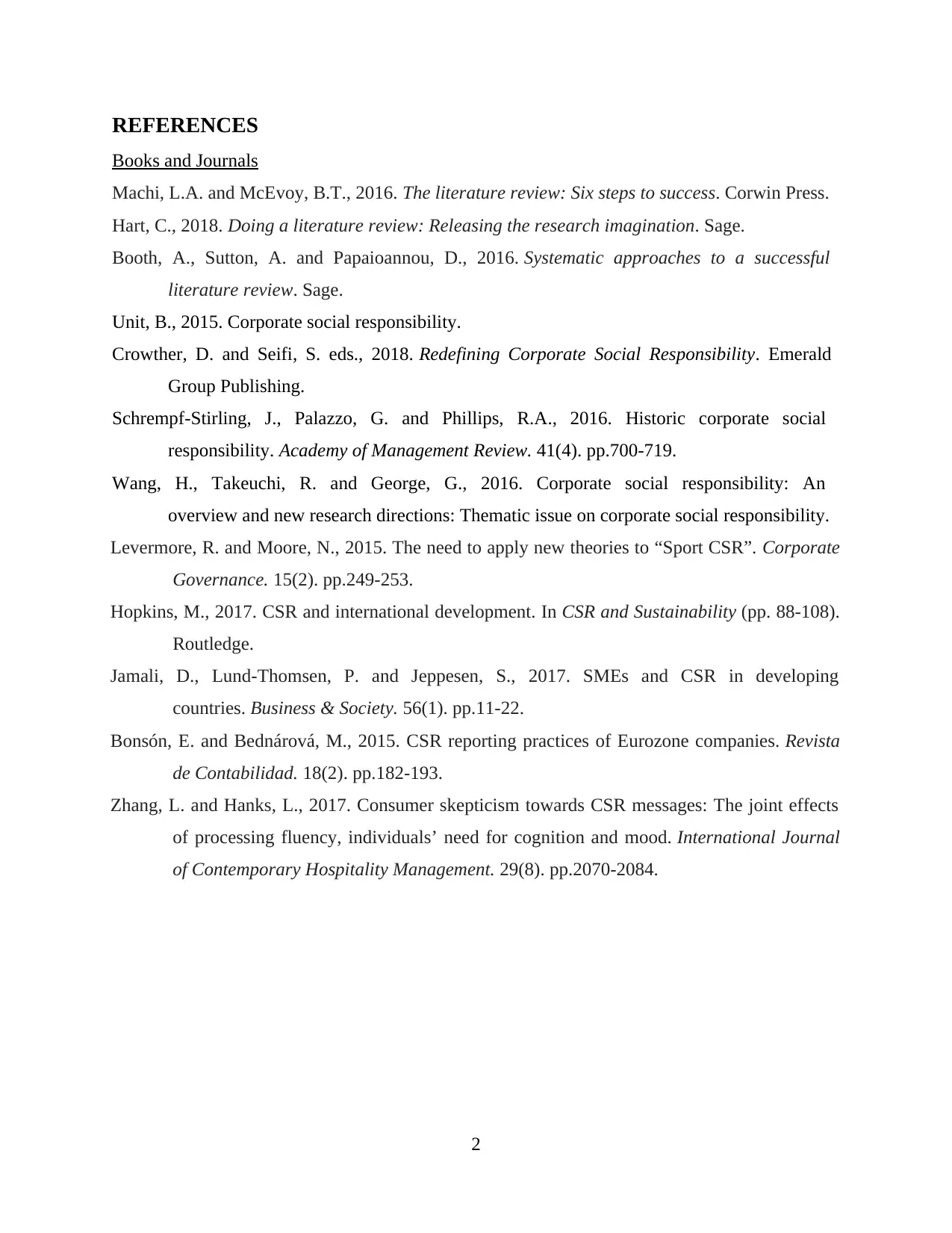
REFERENCES
Books and Journals
Machi, L.A. and McEvoy, B.T., 2016. The literature review: Six steps to success. Corwin Press.
Hart, C., 2018. Doing a literature review: Releasing the research imagination. Sage.
Booth, A., Sutton, A. and Papaioannou, D., 2016. Systematic approaches to a successful
literature review. Sage.
Unit, B., 2015. Corporate social responsibility.
Crowther, D. and Seifi, S. eds., 2018. Redefining Corporate Social Responsibility. Emerald
Group Publishing.
Schrempf-Stirling, J., Palazzo, G. and Phillips, R.A., 2016. Historic corporate social
responsibility. Academy of Management Review. 41(4). pp.700-719.
Wang, H., Takeuchi, R. and George, G., 2016. Corporate social responsibility: An
overview and new research directions: Thematic issue on corporate social responsibility.
Levermore, R. and Moore, N., 2015. The need to apply new theories to “Sport CSR”. Corporate
Governance. 15(2). pp.249-253.
Hopkins, M., 2017. CSR and international development. In CSR and Sustainability (pp. 88-108).
Routledge.
Jamali, D., Lund-Thomsen, P. and Jeppesen, S., 2017. SMEs and CSR in developing
countries. Business & Society. 56(1). pp.11-22.
Bonsón, E. and Bednárová, M., 2015. CSR reporting practices of Eurozone companies. Revista
de Contabilidad. 18(2). pp.182-193.
Zhang, L. and Hanks, L., 2017. Consumer skepticism towards CSR messages: The joint effects
of processing fluency, individuals’ need for cognition and mood. International Journal
of Contemporary Hospitality Management. 29(8). pp.2070-2084.
2
Books and Journals
Machi, L.A. and McEvoy, B.T., 2016. The literature review: Six steps to success. Corwin Press.
Hart, C., 2018. Doing a literature review: Releasing the research imagination. Sage.
Booth, A., Sutton, A. and Papaioannou, D., 2016. Systematic approaches to a successful
literature review. Sage.
Unit, B., 2015. Corporate social responsibility.
Crowther, D. and Seifi, S. eds., 2018. Redefining Corporate Social Responsibility. Emerald
Group Publishing.
Schrempf-Stirling, J., Palazzo, G. and Phillips, R.A., 2016. Historic corporate social
responsibility. Academy of Management Review. 41(4). pp.700-719.
Wang, H., Takeuchi, R. and George, G., 2016. Corporate social responsibility: An
overview and new research directions: Thematic issue on corporate social responsibility.
Levermore, R. and Moore, N., 2015. The need to apply new theories to “Sport CSR”. Corporate
Governance. 15(2). pp.249-253.
Hopkins, M., 2017. CSR and international development. In CSR and Sustainability (pp. 88-108).
Routledge.
Jamali, D., Lund-Thomsen, P. and Jeppesen, S., 2017. SMEs and CSR in developing
countries. Business & Society. 56(1). pp.11-22.
Bonsón, E. and Bednárová, M., 2015. CSR reporting practices of Eurozone companies. Revista
de Contabilidad. 18(2). pp.182-193.
Zhang, L. and Hanks, L., 2017. Consumer skepticism towards CSR messages: The joint effects
of processing fluency, individuals’ need for cognition and mood. International Journal
of Contemporary Hospitality Management. 29(8). pp.2070-2084.
2
1 out of 10
Related Documents
Your All-in-One AI-Powered Toolkit for Academic Success.
+13062052269
info@desklib.com
Available 24*7 on WhatsApp / Email
![[object Object]](/_next/static/media/star-bottom.7253800d.svg)
Unlock your academic potential
Copyright © 2020–2025 A2Z Services. All Rights Reserved. Developed and managed by ZUCOL.





